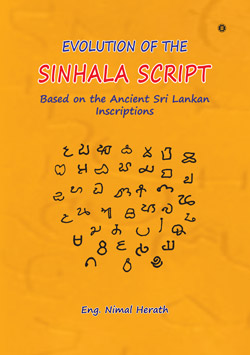From Brahmi script to modern Sinhala alphabet
View(s):Nimal Herath, an engineer by profession, has now written a book on ‘epigraphy’, the study of inscriptions. How he moved from engineering to archaeology, particularly to paleography, is a matter of interest.
His latest book, “Evolution of the Sinhala Script Based on the Ancient Sri Lankan Inscriptions,” published this year, is a valuable book for both beginners and experts. The Sinhala script is based on one of the two most important scripts of Central India in pre-Christian times: the Brahmi script and the Kharashthi script. Emperor Ashoka used both scripts in his edicts – the Brahmi script in Central India and the Kharōshthi script in Western India. The letters are almost alike but Brahmi was written from left to right, while Kharashthi was written from right to left.
 Venerable Mahinda, the son of Emperor Ashoka, is generally credited with introducing the Brahmi script along with Buddhism to this island. That was in the 3rd century before Christ. The earliest writings in Brahmi are found in caves, on rocks, and on stone slabs. The earliest datable rock inscription refers to ‘Uti Maharaja’ (brother of King Devanampiyatissa, who was the first convert to Buddhism). From the time of King Uttiya, thousands of Brahmi inscriptions have been engraved on rocks and slabs, usually referring to those who donated the caves to Buddhist monks to spend their time in meditation.
Venerable Mahinda, the son of Emperor Ashoka, is generally credited with introducing the Brahmi script along with Buddhism to this island. That was in the 3rd century before Christ. The earliest writings in Brahmi are found in caves, on rocks, and on stone slabs. The earliest datable rock inscription refers to ‘Uti Maharaja’ (brother of King Devanampiyatissa, who was the first convert to Buddhism). From the time of King Uttiya, thousands of Brahmi inscriptions have been engraved on rocks and slabs, usually referring to those who donated the caves to Buddhist monks to spend their time in meditation.
Herath has published nearly eighty inscriptions in his book, arranged in chronological order so that the reader gets an idea about the evolution of the Brahmi letters. The very first cave inscriptions featured are from Vessagiriya in Anuradhapura. Anyone who visits Vessagiriya today (quite close to Isurumuniya) can read these inscriptions without any problem.
In this book, an attempt has been made to show how the Brahmi characters have evolved over time from cave inscriptions to the modern Sinhala alphabet found in Ola leaf and copper-plate Sannas inscriptions of the seventeenth and eighteenth centuries. He has spent many hours analysing the gradual and continuous development of these characters over twenty centuries before putting them in order.
The earliest inscriptions have certain words and phrases that occur quite frequently, such as ‘agatha anagatha catu disa sagasa dine’ meaning that these caves have been donated (“dine“) to the monks (“sagasa”) who had already come (“agatha”) and who are yet to come (“anagatha”) from all four directions (“catu disa”).
This volume is, however, for those readers who already know about the evolution of the Brahmi Script.
I shall be happy if the author used his knowledge to publish another volume for beginners, describing: (a) The art of “Epigraphy”, the study of inscriptions, (b) How inscriptions are copied into estampages for preservation, (c) Where these inscriptions are published for scholars to read and comment on them (such as “Epigraphia Zeylanica“) and (d) Names of some of the more famous epigraphists who have worked for days in the jungles and under the sun.
The book, priced at Rs. 2900,
is available at Barefoot
and Sarasavi Bookshops.
| Book facts | |
| Evolution of the Sinhala Script Based on the Ancient Sri Lankan Inscriptions by Nimal Herath Reviewed by Emeritus Professor J. B. Disanayaka |
Searching for an ideal partner? Find your soul mate on Hitad.lk, Sri Lanka's favourite marriage proposals page. With Hitad.lk matrimonial advertisements you have access to thousands of ads from potential suitors who are looking for someone just like you.


